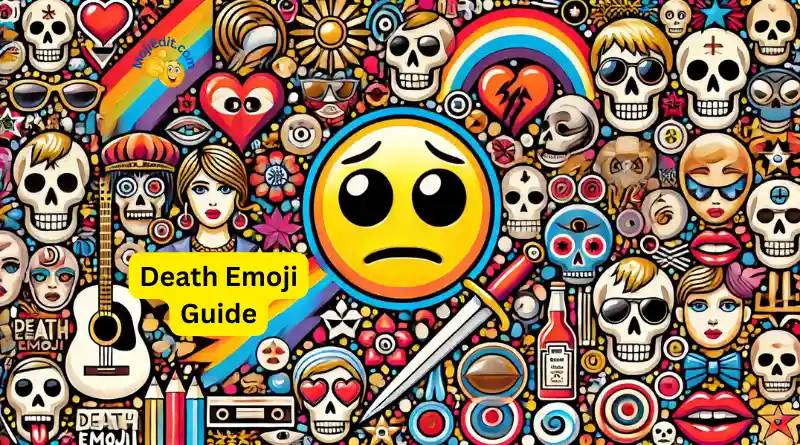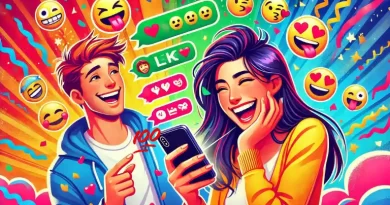Death Emoji Guide 💀: From Dark Humor to Digital Expression
Hey emoji lovers! 😍 Ready to dive into the fascinating world of the death emoji 💀? This little symbol has a lot more going on than you might think! Sure, it’s often associated with danger or death ⚠️, but it’s also taken on a whole new life in our texts and social media posts. 📱
When you see it in a chat, it might mean someone is “dying” of laughter 😂 or feeling super embarrassed 😳. But hold on, interpreting the death emoji isn’t always straightforward. Its meaning can change based on context and culture 🌍. So, let’s break it down together!
Key Takeaways
-
Versatile Symbolism: The death emoji, primarily representing death and danger, also conveys intense laughter or embarrassment in digital conversations.
-
Cultural Interpretations: Different cultures view the death emoji and skull symbols uniquely, from Western associations with fear to Mesoamerican celebrations of life cycles.
-
Historical Significance: Skulls have long held symbolic power across cultures, from ancient rituals to Buddhist teachings, influencing how the death emoji is perceived today.
-
Modern Pop Culture Icon: The death emoji has permeated fashion, music, and movies, symbolizing rebellion and non-conformity in various artistic expressions.
-
Psychological Insights: Frequent use of the death emoji may reflect underlying anxieties about mortality, offering a digital expression for complex emotions related to fear of death.
-
Design Evolution: The appearance of the death emoji varies across platforms, showcasing changes in graphic design trends and user preferences over time.
-
Potential Misunderstandings: Misuse of the death emoji can lead to misunderstandings or offense, highlighting the importance of mindful usage considering cultural and personal sensitivities.
Unicode Introduction
The death emoji 💀, also known as the skull emoji, was introduced to the digital world with the release of Unicode 6.0 in October 2010. Unicode is the standard for text encoding that ensures consistency across different devices and platforms. The skull emoji was given the Unicode point code U+1F480.
Evolution of the Design
Since its introduction, the death emoji has undergone several design changes across different platforms. Each platform, such as Apple, Google, Microsoft, and Samsung, has its unique style and interpretation of the skull emoji. These designs vary from realistic depictions to more stylized and cartoonish versions.
Fun Facts and Usage
-
Versatility: While the death emoji traditionally signifies danger or death, it’s also widely used to express extreme reactions like “dying of laughter” 😂 or embarrassment 😳.
-
Cultural Significance: The skull symbol has deep roots in various cultures. For example, in Mexican culture, skulls are a prominent part of Dia de los Muertos (Day of the Dead) celebrations, symbolizing the celebration of life and death.
-
Pop Culture Impact: The skull emoji has transcended digital communication, becoming a popular symbol in fashion, music, and movies. It’s often associated with rebellion and non-conformity, making it a staple in edgy and alternative styles.
-
Psychological Insight: Some studies suggest that frequent use of the death emoji might reflect underlying anxieties about mortality or a way to cope with heavy emotions through humor.
-
Design Variations:
- Apple: Known for a more realistic and detailed skull design.
- Google: Adopts a simpler, bold-outline style.
- Microsoft: Features a cartoonish and colorful version.
- Samsung: Uses a bright, simplified design with distinctive colors.
Unicode Details
- Year of Release: 2010
- Unicode Version: 6.0
- Code Point: U+1F480
- Block: Emoticons
The death emoji 💀 is much more than just a symbol of death or danger. Its rich history, diverse cultural significance, and evolving design make it a fascinating subject in the study of digital communication. From expressing extreme emotions to serving as a cultural icon, the skull emoji continues to be a versatile and widely recognized symbol in our digital lexicon.
Copy and Paste the Death Emoji 💀
Want to add some edgy flair to your messages or posts? You can easily copy the death emoji and paste it wherever you want to make a statement. Follow these simple steps:
- Click the “Copy” button below to copy the death emoji to your clipboard.
Emoji Copied! 💀
- Go to the place where you want to use the emoji and right-click on the text field.
- Choose “Paste” from the context menu, or simply use the keyboard shortcut Ctrl + V (Windows) or Cmd + V (Mac) to paste the emoji.
And voilà! You’re all set to add a touch of intrigue to your conversations.
Related Emojis and Their Use with the Death Emoji 💀
The death emoji 💀 is often used in combination with other emojis to enhance the meaning or to create a specific tone in digital communication. Here are some related emojis and how they are commonly used alongside the death emoji:
😂 Face with Tears of Joy
- Use: When paired with the death emoji, it signifies extreme laughter. For example, “That joke was so funny, I’m dying 😂💀.”
- Context: This combination is often used to emphasize that something is hilariously funny, to the point of “dying” from laughter.
☠️ Skull and Crossbones
- Use: Both the skull and crossbones and the death emoji signify danger or something deadly. Together, they can amplify the sense of danger or a warning.
- Context: Commonly used in contexts like “This situation is dangerous 💀☠️.”
🎃 Jack-O-Lantern
- Use: During Halloween, combining the death emoji with the pumpkin emoji, or other Halloween emojis, can add a spooky, festive vibe to messages.
- Context: Perfect for Halloween greetings, such as “Happy Halloween! 🎃💀.”
😱 Face Screaming in Fear
- Use: When used with the death emoji, it can express fear or shock.
- Context: Ideal for reacting to scary stories or surprising news, like “That movie was terrifying! 😱💀.”
👻 Ghost
- Use: Pairing the ghost emoji with the death emoji adds a supernatural or haunted element to your message.
- Context: Great for spooky tales or ghost stories, such as “I think my house is haunted! 👻💀.”
🪦 Headstone
- Use: This combination is often used to signify death more explicitly, especially in a literal or grave context.
- Context: Suitable for discussions about death or memorials, like “Rest in peace 🪦💀.”
😈 Smiling Face with Horns
- Use: Combining the death emoji with the devilish smiling face can convey mischievous or dark humor.
- Context: Useful in playful, yet darkly humorous contexts, such as “You’re up to no good 😈💀.”
🎶 Musical Notes
- Use: When paired with the death emoji, it can indicate that a song or performance is “killer” or exceptionally good.
- Context: Ideal for praising music, like “That concert was killer! 🎶💀.”
🔪 Kitchen Knife
- Use: Together with the death emoji, it can signify danger, threat, or something intense.
- Context: Often used in dramatic or thrilling contexts, like “That plot twist was brutal! 🔪💀.”
These combinations of emojis can help convey nuanced emotions and contexts in digital conversations. Using related emojis with the death emoji enhances the intended message and adds depth to your online communication.
Decoding the Intricacies of the Death Emoji
The skull emoji, with its various interpretations and applications, offers a fascinating study in digital communication. Let’s delve deeper into what this versatile symbol represents.
A Glimpse at Dark Humor: The Skull Emoji Edition
Digital platforms often use emojis as an extension of human emotions or expressions. A classic example is the usage of the skull emoji to express dark humor – it is indeed intriguing how one tiny symbol can signify something so profound.
This interpretation revolves around serious topics like death – core themes within darker comedic genres. But remember, decoding such symbolism needs care. Without proper context, your message might land on unintended grounds.
Sporting Banter & Victory: Unconventional Uses for The Skull Emoji
Beyond morbid implications lies another layer in understanding the skull emoji – sports banter. Yes, you heard that right. In friendly sporting exchanges and aggressive gameplay discussions online, our little friend here morphs from a symbol of mortality to one representing victory or domination.
Next time you’re partaking in a heated gaming session or passionately debating over live sports events online, don’t be surprised if someone drops a cheeky skull emoji after winning their round – they’re just basking in their triumph using modern-day hieroglyphics.
Cultural Chronicles: Historical Significance Of Skulls
Isn’t it amazing how much meaning we can extract from simple symbols? And guess what? There’s more where that came from. Our journey doesn’t end here; up next are historical perspectives surrounding skulls across different cultures worldwide.
Stay tuned because we’re about to dive deep into ancient rituals involving skulls.
Cultural and Historical Significance of Skulls
Skulls hold a fascinating place in cultural symbolism across the globe. They serve as powerful reminders of mortality, appearing in ancient relics and modern digital communication.
Exploring the history of skulls reveals intriguing insights into how different cultures interpret them. From Celtic tribes to African societies, skulls were often revered as sacred symbols, believed to house our souls or carry ancestral wisdom.
Mesoamerican Interpretations
Traveling back in time to Mesoamerica, we explore the ancient Aztec and Mayan reverence for skulls as symbols of life’s cyclicality. The Aztecs and Mayans, for instance, viewed skulls not just as grim reminders of death, but as essential elements representing the cyclical nature of life.
These beliefs have transcended centuries, shaping contemporary traditions like Dia de los Muertos (Day of the Dead), where sugar skulls serve as sweet tributes to honor departed loved ones. This tradition exemplifies how historical significance influences cultural interpretations of skulls today.
Buddhist Perspectives on Skull Symbolism
Another path leads us to Eastern philosophies like Buddhism. In Buddhist teachings, death is not feared but embraced as an opportunity for spiritual awakening, bringing one closer to enlightenment or Nirvana. As a result, skull imagery frequently adorns Buddhist art, symbolizing this profound concept.
A Modern Take: Dark Humor & Skull Symbolism
In recent times, “dark humor,” which often revolves around serious topics such as death, has incorporated skull symbolism into its narrative. For example, the use of the skull emoji signals intense laughter, to the point of “killing” someone, and has become widespread on social media platforms.
Note: The broad spectrum of historical significance provides context for current-day uses, including emoticons such as smileys featuring variations of traditional symbols. It is essential to bear in mind the past when examining how skull symbols are seen and understood in modern-day culture. Next up: Let’s delve deeper into the role of skulls in pop society
Key Takeaway:
Skulls have been revered symbols across cultures, signifying mortality and spiritual wisdom. From Mesoamerican societies honoring the cyclical nature of life to Buddhist teachings embracing death as a path to enlightenment, skull symbolism is deeply rooted in history. In modern times, this emblem has found its way into dark humor and digital communication.
The Skull Emoji: A Cultural Icon
Have you ever wondered about the widespread presence of the skull emoji in popular culture? From music to fashion, this small symbol has carved out a significant niche for itself.
“The skull emoji is not just an icon; it’s a cultural phenomenon that resonates with themes of rebellion and non-conformity.”
A Fashion Statement Like No Other
Fashion designers have been drawn to the bold symbolism of the skull. This edgy motif frequently appears on runways, making its way into everyday wardrobes around the world.
One can’t discuss skulls in fashion without mentioning Alexander McQueen, whose designs often feature this potent symbol. Unfortunately, we’re unable to directly link to his collections due to restrictions, but rest assured they are worth checking out.
The Big Screen Embraces The Skull Emoji
In movies and TV shows alike, directors use emojis as subtle character development tools or even plot devices. The Iron Man franchise showcases Tony Stark’s penchant for emojis, including our star – the iconic skull.
Sounds Of Rebellion In Music Genres
Genres like punk rock and heavy metal have always had a fascination with deathly imagery – think skulls. As digital communication took off, so did their love affair with none other than… yes, you guessed right – our friend ‘Skull Emoji’.
We wish we could share Billboard’s comprehensive piece discussing how these genres embraced such symbols over time… but alas.
Navigating Psychological Undercurrents: Fear And Mortality Anxiety?
Given that humans instinctively associate skulls with mortality, one might wonder if using this emoji signifies underlying anxieties related to life’s impermanence.
If indeed users were expressing fear or anxiety via their keyboard taps… well, wouldn’t that be something?
Key Takeaway:
From fashion runways to the big screen, and even music genres, the skull emoji has made a lasting impact. It’s not just an icon; it’s a symbol of rebellion that resonates with people worldwide. However, its use might also reflect deeper psychological undercurrents related to mortality anxieties.
Psychological Interpretations of the Skull Emoji
In our digitally connected world, emojis like the skull have taken on profound psychological meanings. These symbols serve as powerful tools for expressing complex emotions and ideas.
The digital language we use, including emojis, can offer insights into our collective consciousness. This includes fears and anxieties that might be difficult to express through words alone.
Mortality Anxiety Expressed Through Emojis
Humans are wired to grapple with their mortality – it’s a part of who we are. The skull emoji has become an intriguing way in which this fear is expressed within digital conversations.
From ancient civilizations to modern cultures worldwide, skulls often symbolize death or danger. So when people sprinkle their chats with skull emojis, they could be hinting at an underlying anxiety about life’s impermanence without explicitly saying so.
Fear Of Death And Its Digital Expression
We’ve seen how words can sometimes fall short when trying to convey complex feelings like fear. Here’s where the beauty of visual language shines. Emojis allow us to communicate these intricate emotions effectively.
Amongst numerous studies on emotive communication, there is evidence suggesting frequent usage of the skull emoji links back to expressions related to fears associated with death. Moreover, some individuals employ this symbol ironically – making light-hearted comments around serious subjects as a coping mechanism against such profound fears.
Influence Of Frequent Usage Of The Skull Emoji On Perception
It brings up an interesting question: Could constant exposure and use of symbols such as skulls influence our thoughts and feelings towards topics like death? There’s certainly room for exploration here.
Research does indicate that repeated interactions with specific emoticons can significantly impact users’ mental states. Consequently, if someone frequently uses images suggestive of morbidity (like a skull), it may shape their perceptions around these themes negatively over time.
Getting a good grip on the psychological significance of common emojis gives us fresh insights into our interactions.
Unraveling the Mystery of The Skull Emoji in Communication and Messaging
The digital world has gifted us with emojis, adding a vibrant touch to our online conversations. Among these expressive symbols, the skull emoji stands out as a versatile tool for conveying various emotions and meanings.
Digging Deeper into Emojis: Vehicles for Emotional Expression
In the vast landscape of textual communication, emojis like skulls have carved their own niche. These tiny icons add an element of visual language that words alone may struggle to convey.
The death emoji isn’t just about morbidity or danger—it’s more than meets the eye. It can indicate humor (especially when you’re ‘dying’ from laughter), express disbelief or even sarcasm. Its flexibility is part of its charm.
Keep in mind though; interpretation varies across cultures and personal experiences—so it might not always hit the mark universally.
The Game-Changing Impact on Textual Communication
Symbols like skulls are redefining textual communication by injecting emotional depth into our exchanges. They serve as tone indicators—an aspect often missing from text—and help avoid misinterpretations caused by ambiguity.
A Peek at The Many Faces Of The Skull Emoji
Navigating Through Time: Evolution Of The Skull Emoji Design
If you’re curious about how much these designs vary, Google’s latest Android update presents strikingly different versions compared to earlier iterations.
Let’s keep going.
Key Takeaway:
Unravel the layers of the skull emoji, and you’ll find it’s more than a morbid symbol. It’s a versatile tool in digital communication, serving as a vehicle for humor, disbelief or sarcasm. But remember, its interpretation can vary across cultures and personal experiences—so tread lightly.
The Variations of the Skull Emoji
Have you ever noticed how the skull emoji appears differently across various platforms? This difference in representation, or the different versions of the skull emoji, is what makes digital communication so intriguing and diverse.
For instance, Apple’s version leans towards a realistic portrayal with intricate shading details. On the other hand, Google embraces simplicity with bold outlines – quite a contrast to Apple’s detailed approach.
Microsoft has chosen to go down a more playful route with its cartoonish design of the skull emoji. Samsung stands out too by incorporating bright colors into their simplified design.
The Design Evolution of the Skull Emoji
If we journey back in time, it becomes evident that our beloved skull emoji wasn’t always as refined as it is today. Its evolution from simple iconography akin to early digital graphics or clip art shows us just how much technology and user preferences have shaped this universal symbol over time.
This shift isn’t merely about aesthetics; there were functional changes made based on usage patterns identified among users worldwide. Such modifications demonstrate how our virtual language continues evolving alongside us – making emojis an integral part of modern-day online conversations.
Misinterpretations and Controversies Surrounding the Skull Emoji
Moving onto another interesting facet: misunderstandings associated with emoticons like the skull emoji due to cultural interpretations. In some cultures, skulls are symbols of mortality or danger; however, the variations of the skull emoji have led them being used light-heartedly—expressing excitement or astonishment online—a stark contrast from traditional symbolism.
The Potential Offensiveness of the Death Emoji
Misunderstandings can often lead to unintentional offense caused by these symbols. Misuse of the skull emoji makes things complicated because what might seem harmless fun could potentially upset someone unaware of your intended meaning.
While most people use it casually without intending harm, it’s important we consider potential misinterpretation when using such controversial symbols. To avoid misunderstanding, it would be beneficial understanding possible interpretations before incorporating them into your daily digital communications.
Next, we’ll dig deeper and discuss why some representations might rub folks the wrong way.
Key Takeaway:
From Apple’s realistic rendering to Google’s bold outlines, the skull emoji varies across platforms. Its evolution mirrors tech advancements and user preferences, highlighting emojis’ integral role in modern digital dialogue. Yet cultural interpretations can lead to misunderstandings; what seems like harmless fun might offend someone unaware of your intended meaning. So tread lightly with this controversial symbol.
Decoding the Enigma: Misinterpretations and Controversies Surrounding The Skull Emoji
In the vast ocean of digital communication, emojis have become our trusty vessels. Yet, sometimes they sail us into murky waters of misunderstanding. One such notorious symbol is the skull emoji.
“Emojis are like a global language, but their interpretation can be as diverse as dialects.”
This brings to light how these misunderstandings – particularly those involving symbols like the skull emoji – can steer conversations off course or even cause offense.
The Potential Offensiveness Of The Skull Emoji: A Closer Look
Symbols hold power; their meanings are rooted in cultural context and personal experiences. In some contexts, this seemingly harmless pictograph could stir up discomfort due to its association with death and morbidity.
Misuse Of The Skull Emoji often occurs when we forget that not everyone shares our frame of reference. For instance, while younger generations might use it to denote laughter (think “I’m laughing so hard I’m dead”), others may find this usage unsettling or inappropriate.
Avoid Misunderstandings by Mindful Usage
To prevent potential miscommunication resulting from misuse of the skull emoji, one should consider both cultural nuances and individual sensitivities around themes like mortality before using it.
Frequent overuse may also dilute its intended meaning, causing confusion among recipients who aren’t well versed with evolving digital lingo. Remember, less is more, especially when dealing with cryptic symbols.
Cultural Variance in Deciphering Emoticons
Different cultures interpret symbolism associated with skulls differently, which greatly influences how they perceive such icons.
For example, western societies typically associate skeletal imagery with negativity and fear, whereas regions like Mexico celebrate the Day of the Dead festival, which embraces the positive aspects of the life cycle and emphasizes the importance of remembering deceased loved ones rather than fearing the end.
Key Takeaway:
Emojis, like the skull emoji, are a universal digital language but their interpretation can vary greatly. While some see it as a symbol of death and morbidity, others use it to denote extreme laughter. Remember to consider cultural nuances and individual sensitivities before using cryptic symbols like this one in your communication.
Conclusion
We’ve journeyed through its diverse meanings, from the symbol of death and danger to an icon of laughter or embarrassment.
We dove into cultural interpretations and historical significance that give depth to this simple image.
In pop culture, we saw how this emoji has infiltrated various mediums with ease.
Psychologically speaking, it can represent our mortality anxiety or fear of death – quite profound for a tiny pictogram!
The skull emoji’s role in textual conversations is undeniable; expressing emotions digitally wouldn’t be the same without it.
Variations across platforms highlight how design evolution affects interpretation too. Misunderstandings? Yes, they happen but understanding helps mitigate those risks.
Visit Moji Edit, your one-stop resource for all things emojis! Whether you’re curious about different smileys or want to delve deeper into their meanings like we did today with “The Skull Emoji”, there’s something for everyone at Moji Edit. Uncover the intriguing world of emoticons and enrich your digital conversations.
Frequently Asked Questions and Answers
The death emoji primarily represents death, danger, or dark humor. However, it can also express intense laughter in internet slang.
It’s often used in a hyperbolic way to express extreme reactions, like laughing very hard or being shocked, adding a dramatic flair to conversations.
Yes, its use can lead to misunderstandings or offense, especially if the receiver interprets it differently than intended.
In Western cultures, it typically signifies fear or danger. However, in cultures like Mexico, where Day of the Dead celebrations honor deceased loved ones, it might be seen more positively.
It can symbolize anxieties about mortality and the fear of death. Its frequent use might reflect underlying psychological concerns.






